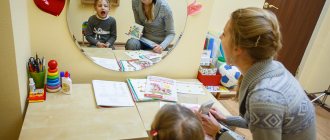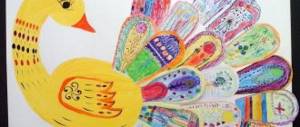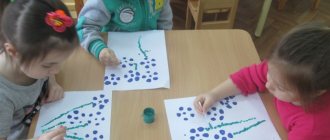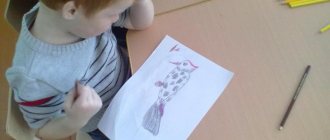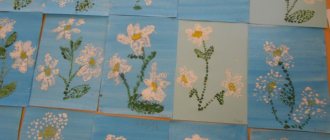Self-analysis of an art lesson
Self-analysis of the Fine Arts lesson Serysheva E.V.
This lesson was taught in 4th grade. There are 8 students in the class (three girls and five boys). Children have different levels of development, so when working, I took into account the capabilities of each student. The class was divided into two groups. The guys in this class are very emotional, all the guys are very lively and active. Training is carried out according to the program “Fine Arts and Artistic Work”, the author of the program is B. Nemensky.
Lesson topic:
- Land of the rising sun. An image of Japanese artistic culture.
- Cherry blossom festival."
The objectives of the lesson were realized through the following aspects:
- Educational: introduce students to the national cult of honoring the cherry blossom festival in Japan;
- teach children to understand the place and role of nature in human life;
- to develop the ability to expressively use in collective work: the texture of materials, the colors of the composition, the ability to coordinate details with each other to combine them into a holistic ensemble.
- develop the aesthetic taste of students;
- cultivate a sense of tolerance towards foreign cultures;
During the lesson I used presentations, musical compositions, and handouts for decorating panels.
Lesson type: combined.
Lesson format: conversation, practical work.
Technologies used:
- informational;
- health-saving;
- gaming
Methods used:
- illustrative and visual;
- verbal;
- self-organization;
- reflection.
Equipment:
- multimedia projector;
- computer;
- screen;
- check tables;
- image of a tree.
After the lesson, students will be able to:
- apply the knowledge acquired in the lesson in other subjects (history, literature);
- apply the skills of making a cherry blossom tree in other art and technology classes;
- be tolerant.
I tried to structure the lesson so that it was productive, interesting and initially tried to establish cooperation between me and the children.
At the organizational stage of the lesson, I created an emotional mood for the upcoming work through a non-traditional greeting (poem), as well as solving a rebus.
This lesson is the next according to the plan, in which the goal was set to show the work of the teacher, namely to show what methods can be used in fine arts lessons, how information and communication technologies are used.
To prepare this lesson, I studied and tested material on this topic (1 lesson out of 3), where TSO materials were used (computer, multimedia installation).
This lesson has interdisciplinary connections with history, geography, and technology.
Lesson steps:
1. Organizational moment. Did. goal: Self-organization for activity (to provide a normal external environment for work in the lesson and psychologically prepare students for communication and the upcoming lesson); reminder of safety regulations.
2. Work on the topic of the lesson. Actualization of mental activity.
Did. goal: Organize and target the cognitive activity of students, prepare them to master new material.
3. Communicate the topic and objectives of the lesson.
Did. goal: To form the purposeful nature of students' educational activities. Teach students to formulate a goal and choose specific means to achieve it.
4. Explanation of the work progress (origami)
Did. goal: To give students a concrete idea of the facts being studied (sakura). To ensure that students master the methods, paths, and means that led to the generalization of knowledge. To ensure that students master the method of reproducing the material being studied. Based on the acquired knowledge, develop appropriate skills and abilities.
5. Physical exercise
Did. goal: Restoring the student’s physical and spiritual strength.
6. Doing the work independently. Decoration work.
Did. goal: To consolidate in the memory of students the knowledge and skills that they need for independent work on new material. To achieve, during consolidation, an increase in the level of comprehension of the studied material and the depth of its understanding. Develop appropriate skills and abilities.
7. Step-by-step design of the panel.
Did. goal: To consolidate in the memory of students the knowledge and skills that they need for independent work on new material. To achieve, during consolidation, an increase in the level of comprehension of the studied material and the depth of its understanding. Develop appropriate skills and abilities.
8. Summary. Exhibition of works.
Did. goal: Summarize the lesson. Provide an analysis of the success of mastering knowledge and methods of activity, show typical deficiencies in knowledge and skills.
The structure of the lesson was consistent, all stages of the lesson had a logical connection. To conduct the lesson, time was planned in advance for the implementation of the stages of the lesson, where more time was allocated for the practical part.
For the practical part of the lesson, templates were prepared in advance, which made it possible to reduce the time for students to work independently.
The topic of volumetric applique, in my opinion, is one of the most difficult topics. This is due to the specifics of paper processing, bending techniques, and folding parts in a certain sequence. This art, which attracts both adults and children, has long crossed the borders of its homeland Japan, becoming widespread in many countries (the art of origami).
Paper, an accessible and universal material for any child, is widely used not only in drawing and appliqué, but also in artistic design. Through various actions with paper, in the process of processing it, using different methods and techniques, children learn to aesthetically comprehend samples of familiar objects, convey them in visual activity, emphasizing the beauty and colorfulness of the appearance in a transformed form.
Such activities are of great importance in the development of the child’s creative imagination, his imagination, artistic taste, accuracy, the ability to carefully and economically use material, outline a sequence of operations, actively strive to obtain a positive result, and keep the workplace in order. Children acquire skills and a work culture that are important for their success in school.
Combined lesson type. Combined lessons are especially widespread in the lower grades of school. This is explained by the age characteristics of younger schoolchildren (instability of attention, increased emotional excitability). In the elementary grades, it is necessary to combine different types of educational work, combine the communication of new knowledge with primary consolidation, repetition of previously learned. This particular lesson is called a combined, or structurally complex, lesson. Therefore, in order to fully achieve my goals, I chose this particular type of lesson.
By becoming familiar with the origins of the culture of their people or other peoples of the Earth, children begin to feel themselves participants in the development of humanity, opening up the path to further knowledge of the wealth of human culture, people’s ideas about nature, art, work, and the beauty of human relationships.
Training sessions provide for further development of skills in working with gouache, plasticine, paper, and watercolors. The tasks of labor education are organically connected with artistic tasks. In the process of mastering the skills of working with a variety of materials, children come to understand the beauty of creativity.
The lesson took place in a friendly atmosphere. The students were liberated and relaxed. I managed to arouse children's interest in the material being studied. The use of ICT helped me a lot with this at different stages of the lesson. I believe that the triune goal of the lesson was achieved, since all students successfully completed the task. The works turned out good, neat, all different, since each child creatively approached the decoration of the product (flowers).
Self-analysis of the visual arts lesson. The topic of the lesson is “Showcases” (3rd grade).
Fine arts lesson in 3rd grade.
Topic: "Showcases".
Goal: to develop knowledge about the variety of artistic design of store windows.
Tasks:
1. To develop skills in working with various artistic materials to create a store window using the collage technique.
2. Develop artistic taste, creative activity, imagination, memory, spatial thinking.
3. Foster interest and respect for the designer profession; instill love and respect for the world around us.
Planned results:
Subject : to promote the development of aesthetic taste, artistic thinking; build logically sound reasoning.
To train students in the use of various materials and means of artistic expression to convey ideas in their own activities.
Meta-subject: they will learn to determine a goal, participate in a dialogue with the teacher, and express their opinion; create oral texts to solve a learning problem; plan activities, work according to plan; determine ways to achieve the goal; express your opinion, accept the position of your classmates.
Personal: show interest in learning new material, cognitive activity; are aware of their emotions; develop their ideological positions; Reasonably evaluate their own work and the work of their classmates.
Equipment : textbook L.A. Nemenskaya, “Showcases” slides, photos with examples of window display design, design blanks for display.
Lesson format: conversation, practical work.
Technologies used:
- informational;
- health-saving;
- gaming
Taking into account the already formed UUD and the tasks assigned to the student, I chose the following methods:
Methods used:
- illustrative and visual;
- verbal;
- self-organization;
- reflection.
Equipment:
- multimedia projector;
- computer;
- screen;
I tried to structure the lesson so that it was productive, interesting and initially tried to establish cooperation between me and the children. All lesson objectives are interconnected and aimed at achieving the lesson goal.
I also took into account the specifics of the subject, so the form of work was frontal (at almost all stages of the lesson) and paired (during practical work).
Lesson steps:
1. Org. moment. Goal: Self-organization for activity (to provide a normal external environment for work in the lesson and psychologically prepare students for communication and the upcoming lesson);
2. Actualization of mental activity.
Goal: Organize and target the cognitive activity of students, prepare them to learn new material.
3. Communicate the topic and objectives of the lesson.
Goal: To form the purposeful nature of students’ educational activities. Teach students to formulate a goal and choose specific means to achieve it.
4. Explanation of new material.
Purpose: To give students a specific idea and to ensure that students master the method of reproducing the material being studied. Based on the acquired knowledge, develop appropriate skills and abilities.
5. Physical education minute
Goal: Restoring the student’s physical and spiritual strength.
6. Practical work.
Goal: To consolidate in the memory of students the knowledge and skills that they need to independently work on new material. To achieve, during consolidation, an increase in the level of comprehension of the studied material and the depth of its understanding. Develop appropriate skills and abilities.
7. Lesson summary. Exhibition of works.
Purpose: Summarize the lesson. Provide an analysis of the success of mastering knowledge and methods of activity, show typical deficiencies in knowledge and skills.
8. Reflection.
The structure of the lesson is consistent and was built in such a way as to arouse children's interest and the need to acquire new knowledge. The volume of lesson material and the complexity of information are taken into account with the learning capabilities of children, with their existing knowledge base and skills, and receptivity to information. All stages of the lesson had a logical connection. To conduct the lesson, time was planned in advance for the implementation of the stages of the lesson, where more time was allocated for the practical part. To maintain performance and better assimilate the material, I alternated forms and methods of work. To change activities, I used physical education. Rational use of time in the lesson contributed to the implementation of the planned plan. At the end of the lesson, a conclusion and reflection were summed up.
Combined lesson type. The principles selected in its content are: clarity, scientificity, accessibility, connection with life, the principle of problem-based learning.
The lesson took place in a friendly atmosphere. The students were liberated and relaxed. Activity and efficiency were observed throughout the lesson. I managed to arouse children's interest in the material being studied. The use of ICT helped me a lot with this at different stages of the lesson. Communication between students and teacher was friendly. In this lesson, the children and teacher worked collaboratively with each other.
I believe that the triune goal of the lesson was achieved, since all students successfully completed the task. The works turned out good, neat, all different.
Self-analysis of an open lesson on technology in grade 7 on the topic “Crochet”
Self-analysis of the lesson on the topic:
“Crochet” in 7th grade (1 hour)
The technology lesson in 7th grade was conducted in accordance with calendar and thematic planning.
Lesson objectives:
— Educational
: consolidate the acquired knowledge, learn to apply it in practice: read diagrams, organize the workplace; instill interest in culture and art, improve aesthetic taste.
— Developmental:
develop sensory and motor skills, develop cognitive activity by creating problem situations.
— Educational
: cultivate a love of needlework, be able to work in pairs, groups, be able to listen to others.
In the class in which the lesson was taught there were 4 students with a high level of learning ability.
During the lesson, technology formed the following UUD:
Personal UUD
- Manifestation of cognitive interests and creative activity in this area of subject technological activity.
- Expression of desire to study and work in production to meet current and future needs.
- Development of hard work and responsibility for the quality of one’s activities.
- Mastery of guidelines, norms and rules for the scientific organization of mental and physical labor.
- Self-assessment of one’s mental and physical abilities for work in various fields from the perspective of future socialization.
Cognitive UUD
- Assessment of technological properties of materials and areas of their application;
- Knowledge of algorithms and methods for solving technical and technological problems;
- Recognition of types of tools, devices and equipment and their technological capabilities;
- Knowledge of reading methods and methods of graphical presentation of technical and technological information;
- Application of general scientific knowledge in the process of implementing rational technological activities.
Regulatory UUD
1. Express your proposal based on the educational material;
2. Exercise self-control;
3. Together with the teacher and classmates, evaluate and mutually evaluate your activities in the lesson.
Communicative UUD
- Take into account different opinions and strive to coordinate different positions in cooperation.
During the lesson, various forms of educational activity were used: individual, frontal.
To increase the level of activation, the following techniques were used: game moments, presentation, demonstration of finished product samples. Students were actively involved in all forms of work, completed assignments with interest and answered questions. There were no problems with discipline. The lesson went at a good pace.
In accordance with the objectives of the lesson, 25 minutes were allocated for the practical part. Practical work was accompanied by a pedagogical demonstration of knitting techniques during ongoing instruction, which provided a favorable, trusting atmosphere. Before it began, a safety briefing was conducted and a stage of updating knowledge on the topic was carried out. The criteria for evaluating the work were named. All students successfully completed the task. Thus, I believe that the goal set at the beginning of the lesson has been achieved. At the end of the lesson, reflection was carried out, which showed the following: 1 student believes that the knowledge given in the lesson is unlikely to be useful in life, 75% considered the acquired skills useful. The grade for the lesson consisted of self-assessment, mutual assessment and teacher assessment. Final grade - the average score will be given at the end of the second lesson, as well as the homework assignment will be given at the second lesson.
